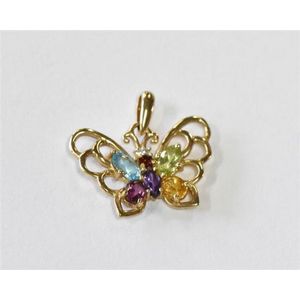Victorian Diamond Bee Brooch
You must be a subscriber, and be logged in to view price and dealer details.
Subscribe Now to view actual auction price for this item
When you subscribe, you have the option of setting the currency in which to display prices to $Au, $US, $NZ or Stg.
- Rose Cut - A flat based cut for a preious stone, leaving the surface covered with triangular facets, usually 24 in total.
It was introduced in the 15th century and popular during the 16th and 17th centuries.
The rose cut was the most popular form of diamond cut until the discovery of the brilliant cut at the end of the 17th century, after which its use declined. - Bee Motif - The bee is a popular motif in jewellery design, often used to symbolize industry, hard work, and the natural world. They can be depicted in a variety of styles, from realistic to stylized, and are often used as a decorative element on rings, pendants, earrings, and other types of jewellery. In many cultures, bees are also seen as a symbol of prosperity and good luck, making them a popular choice for talismanic jewellery. Some people also choose to wear bee-themed jewellery as a way to show support for the conservation of bees, which are important pollinators that play a vital role in the health of ecosystems around the world.
- Cabochon Cut in Jewellery - A cabochon cut is a type of gemstone cutting where the stone is cut and polished in a convex shape with a flat bottom and a domed top, with no facets. This type of cut is typically used for opaque or translucent stones that have natural patterns or inclusions that are best displayed in this type of cut. Examples of stones that are often cut as cabochons include turquoise, opal, and moonstone.
- Victorian Period - The Victorian period of furniture and decorative arts design covers the reign of Queen Victoria from 1837 to 1901. There was not one dominant style of furniture in the Victorian period. Designers used and modified many historical styles such as Gothic, Tudor, Elizabethan, English Rococo, Neoclassical and others, although use of some styles, such as English Rococo and Gothic tended to dominate the furniture manufacture of the period.
The Victorian period was preceded by the Regency and William IV periods, and followed by the Edwardian period, named for Edward VII (1841 ? 1910) who was King of the United Kingdom and the British Dominions and Emperor of India for the brief period from 1901 until his death in 1910.
This item has been included into following indexes:
Visually similar items

15ct yellow gold, peridot and seed pearl brooch weight: 3.27 grams

Diamond butterfly brooch, 14ct gold brooch delicately set with old mine cut, rose cut and round brilliant diamonds, approximately 3ct total weight A/F, total weight of 11.5 grams

Good antique 9ct gold sword brooch, set with solid opals, weight: 4.75 grams, size: 8 cm length

9ct yellow gold butterfly pendant, with six coloured stone (peridot, topaz, amethyst, citrine, two garnets and a brilliant cut diamond). Length 2 cm. Weight 1.6g.
